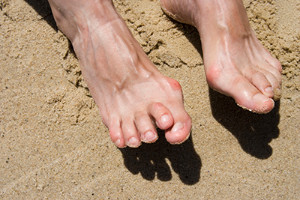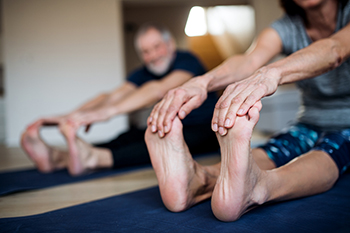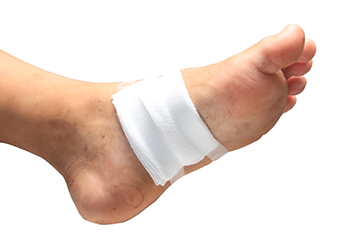
Hammertoe is a deformity where one or more toes bend abnormally at the middle joint, creating a curled or claw-like appearance. It often develops from wearing tight or ill-fitting shoes, muscle imbalance, or trauma to the toe. Risk factors include arthritis, high arches, and genetic predisposition. Symptoms may include pain, swelling, corns, calluses, and difficulty wearing shoes comfortably. Without treatment, the condition can become rigid and more painful over time. A podiatrist can evaluate the severity, recommend proper footwear, prescribe orthotics, and suggest exercises or surgical correction, if needed. If you have painful symptoms of hammertoe, it is suggested that you consult a podiatrist who can guide you toward effective relief and treatment solutions.
Hammertoes can be a painful condition to live with. For more information, contact Bryan Sullivan, DPM of Mississippi Foot Center . Our doctor will answer any of your foot- and ankle-related questions.
Hammertoe
Hammertoe is a foot deformity that occurs due to an imbalance in the muscles, tendons, or ligaments that normally hold the toe straight. It can be caused by the type of shoes you wear, your foot structure, trauma, and certain disease processes.
Symptoms
- Painful and/or difficult toe movement
- Swelling
- Joint stiffness
- Calluses/Corns
- Physical deformity
Risk Factors
- Age – The risk of hammertoe increases with age
- Sex – Women are more likely to have hammertoe compared to men
- Toe Length – You are more likely to develop hammertoe if your second toe is longer than your big toe
- Certain Diseases – Arthritis and diabetes may make you more likely to develop hammertoe
Treatment
If you have hammertoe, you should change into a more comfortable shoe that provides enough room for your toes. Exercises such as picking up marbles may strengthen and stretch your toe muscles. Nevertheless, it is important to seek assistance from a podiatrist in order to determine the severity of your hammertoe and see which treatment option will work best for you.
If you have any questions, please feel free to contact our office located in Jackson, MS . We offer the newest diagnostic and treatment technologies for all your foot care needs.

Ankle pain while running can affect performance and increase the risk of injury, if not properly addressed. Choosing the right running shoes with good support and cushioning can help reduce stress on the joints. Learning proper running techniques, such as landing softly and maintaining good posture, helps prevent unnecessary strain. Additionally, stretching before and after running improves flexibility and reduces tightness in the muscles and tendons surrounding the ankle. A podiatrist can evaluate your foot structure, gait, and footwear to identify the source of pain and create a personalized treatment or prevention plan. If you have ankle pain and enjoy running, it is suggested that you schedule an appointment with a podiatrist who can treat various foot and ankle conditions, enabling you to return to running comfortably and safely.
All runners should take extra precaution when trying to avoid injury. If you have any concerns about your feet, contact Bryan Sullivan, DPM of Mississippi Foot Center . Our doctor will treat your foot and ankle needs.
How to Prevent Running Injuries
There are a lot of mistakes a runner can make prior to a workout that can induce injury. A lot of athletes tend to overstretch before running, instead of saving those workouts for a post-run routine. Deep lunges and hand-to-toe hamstring pulls should be performed after a workout instead of during a warmup. Another common mistake is jumping into an intense routine before your body is physically prepared for it. You should try to ease your way into long-distance running instead of forcing yourself to rush into it.
More Tips for Preventing Injury
- Incorporate Strength Training into Workouts - This will help improve the body’s overall athleticism
- Improve and Maintain Your Flexibility – Stretching everyday will help improve overall performance
- “Warm Up” Before Running and “Cool Down” Afterward – A warm up of 5-10 minutes helps get rid of lactic acid in the muscles and prevents delayed muscle soreness
- Cross-Training is Crucial
- Wear Proper Running Shoes
- Have a Formal Gait Analysis – Poor biomechanics can easily cause injury
If you have any questions, please feel free to contact our office located in Jackson, MS . We offer the newest diagnostic and treatment technologies for all your foot care needs.

Puncture wounds on the feet occur when sharp objects such as nails, glass, or animal teeth pierce the skin and penetrate into deeper tissues. While puncture wounds may seem minor, they often create narrow entry points that drive bacteria and debris beneath the surface, which increases the risk of infection. Because the foot bears weight and is exposed to the ground, puncture wounds in this area can be more complicated than similar injuries elsewhere. Complications may include abscess formation, damage to tendons or bones, or serious infection requiring advanced care. A podiatrist can evaluate the extent of the puncture wound, ensure that any foreign material is safely removed, and determine whether imaging or surgery is necessary. Proper medical care can help prevent long-term problems, such as tissue damage, joint involvement, or in severe cases, limb loss. If you have sustained a puncture wound on the foot, it is suggested that you make an appointment with a podiatrist for an exam and treatment.
Wound care is an important part in dealing with diabetes. If you have diabetes and a foot wound or would like more information about wound care for diabetics, consult with Bryan Sullivan, DPM from Mississippi Foot Center . Our doctor will assess your condition and provide you with quality foot and ankle treatment.
What Is Wound Care?
Wound care is the practice of taking proper care of a wound. This can range from the smallest to the largest of wounds. While everyone can benefit from proper wound care, it is much more important for diabetics. Diabetics often suffer from poor blood circulation which causes wounds to heal much slower than they would in a non-diabetic.
What Is the Importance of Wound Care?
While it may not seem apparent with small ulcers on the foot, for diabetics, any size ulcer can become infected. Diabetics often also suffer from neuropathy, or nerve loss. This means they might not even feel when they have an ulcer on their foot. If the wound becomes severely infected, amputation may be necessary. Therefore, it is of the upmost importance to properly care for any and all foot wounds.
How to Care for Wounds
The best way to care for foot wounds is to prevent them. For diabetics, this means daily inspections of the feet for any signs of abnormalities or ulcers. It is also recommended to see a podiatrist several times a year for a foot inspection. If you do have an ulcer, run the wound under water to clear dirt from the wound; then apply antibiotic ointment to the wound and cover with a bandage. Bandages should be changed daily and keeping pressure off the wound is smart. It is advised to see a podiatrist, who can keep an eye on it.
If you have any questions please contact our office located in Jackson, MS . We offer the newest diagnostic and treatment technologies for all your foot and ankle needs.

